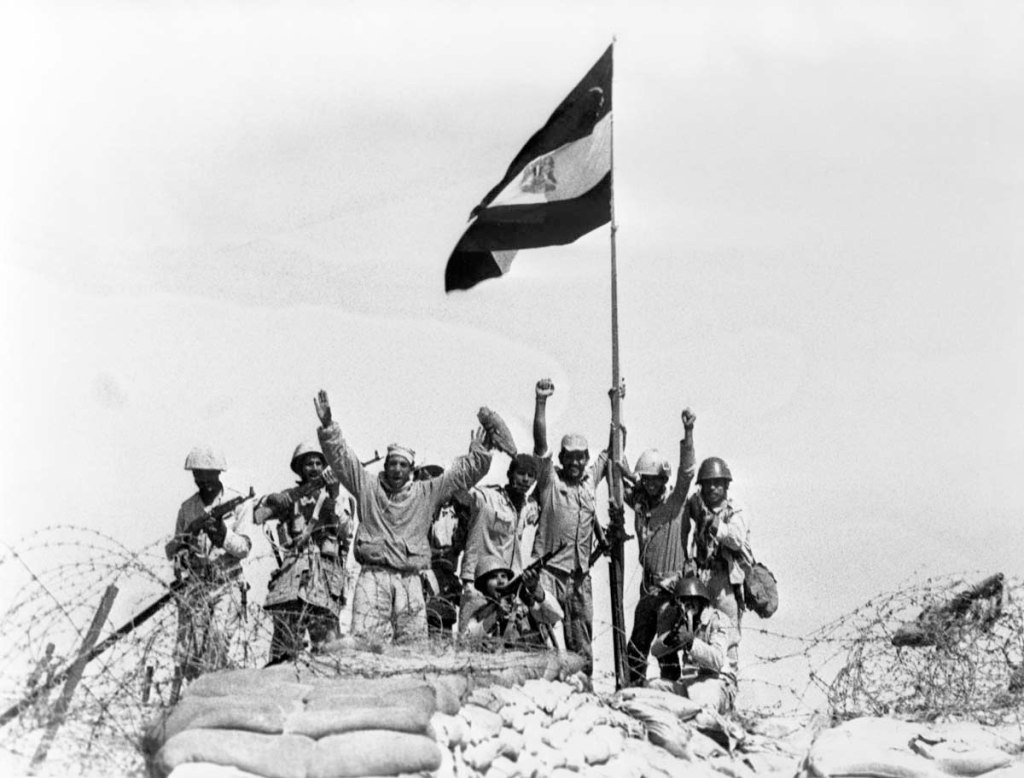Flying to Israel’s aid: former colonel recalls Yom Kippur War deployment
Published 12:00 am Saturday, October 14, 2023

- Egyptian troops pose atop a bunker on which they just planted their flag on the Israeli Bar Lev line east of the Suez Canal, Egypt, on Oct. 13, 1973.
Not many people born more than 50 years ago can remember what they were doing in October of 1973. But for local veteran Ken Brown, it’s a moment in time that’s hard to forget: Then, as now, the period marked an era of tumultuous diplomacy and conflict in the Middle East — and Brown found himself flying straight toward it.
Now a retired U.S. Air Force Colonel, Brown was deployed to Israel as a Military Airlift Command intelligence officer shortly after the Yom Kippur War — a brief but intense conflict between Israel and an Arab-state coalition fronted by Syria and Egypt — erupted on Oct. 6 of 1973. “The Israelis,” he recalls, “had never asked us for help in terms of manpower. But they needed ammunition, and they needed that support quickly. They were defending about three different fronts, and they don’t have any space to trade for time: They couldn’t fall back. They had to hold their ground.”
Stationed at the time not far from St. Louis at Scott Air Force Base in Illinois, Brown rapidly became involved in the United States’ quick-response resupply effort in support of Israel. “My boss said, ‘I want you to forward deploy to Tel Aviv, gather what intelligence you can from the Israelis, and report back to us.’ But mainly, my role was to brief the air crew that were going to be flying all of this stuff in there, and then fly back out again.”
That meant heading to Delaware, where the C-5A Galaxy — the nation’s highest-capacity transport plane — housed the aircraft’s home wing at Dover Air Force Base. “The aircraft was loaded with 175mm ammunition, which are huge shells that stand close to six feet high,” says Brown. “Wall to wall, and looking all the way to the tail, the planes were loaded with hundreds of these heavy artillery shells on pallets. The C-5 I was on was just one of many: It was a complete air bridge, 24 hours a day, going in and out of Israel.”
The plane made only one stop en route to Israel, pausing in the Azores off the coast of Portugal to afford its pilots and crew a strategic respite before continuing their gargantuan trans-Atlantic flight. From there, says Brown, “we headed directly down through the Mediterranean Sea to Tel Aviv.
“The interesting thing about that last leg of the trip,” he adds, “was that about 100 miles out from Tel Aviv, while still over the Mediterranean, we picked up an escort of Israeli F-4 Phantom fighter jets. There were two of them — one on each wing. They were waving at us, and they escorted us the rest of the way into Tel Aviv. They didn’t know what the Egyptian Air Force was going to do in terms of interrupting the air bridge, but there they were — and about five miles from the airport, they turned around to go and get the next C-5. That 100-mile loop was their constant pattern. It was pretty impressive to see.”
Once on the ground, more surprises were in store as Brown got an up-close look at how the Israelis had organized such a quick response to the Arab coalition’s initial Oct. 6 attack.
“We landed and taxied in, and the C-5 opens up at both the nose and the tail, and cargo starts coming out both the front and the back,” he recalled. The Israeli men were all at the front where the fighting was — so the transport trucks where we were being driven by Israeli females wearing IDF [Israeli Defense Forces] uniforms. We asked, ‘Where is this ammo going?’ and they said, ‘We are so close to running out, that we are driving it directly up to the Golan Heights and firing it as fast you guys are bringing it in.’”
Brown’s 10-day stay in Israel spanned nearly half of the three-week conflict, and his duties never afforded him the chance to go off-base. But even in his limited airport confines, he witnessed evidence of how the U.S.-Israeli alliance — whatever its larger global political implications might mean — had been thoroughly integrated into Israeli culture.
“One of the things I found very interesting, during the hour and-a-half or so that the aircraft was being refueled, was that the [American] pilots could come into the lounge, get their weather; get their intel briefing — and in the pilots’ lounge, the Israelis had a huge, wall-sized bulletin board. and on that board, there were notes from all the Israeli school children in Tel Aviv.
“Each of these notes was addressed along the lines of ‘Dear pilot,’ and each of them said things like ‘Thank you for helping my country; for bringing supplies to help our military: We love America; You’re our heroes.’ It was just a wall filled with thank-yous to the American pilots. and every pilot got to take one home as a souvenir.”
Brown says he’s lost track, over the years, of the souvenir note that he took home from his 10-day tour in Israel. But he feels Israel remains equipped to meet sovereign threats not only with might, but with a well-organized and purposeful response informed by the existential threat that defined the European Jewish experience in the aftermath of WWII.
“The Israelis were super friendly and very appreciative of the Americans; very business-focused: They were all business and very competent in the middle of a big war. Everyone I met there, whatever their job was, knew what they were doing and knew that they could count on each other. There was definitely an attitude of ‘never again.’ … You have to think: You have German Jews, Italian Jews, Romanian Jews — these people are all from different cultures and backgrounds. But once they’re settled down in Israel, it’s ‘never again’ for them. That’s what ties them together, and it’s very powerful.”





